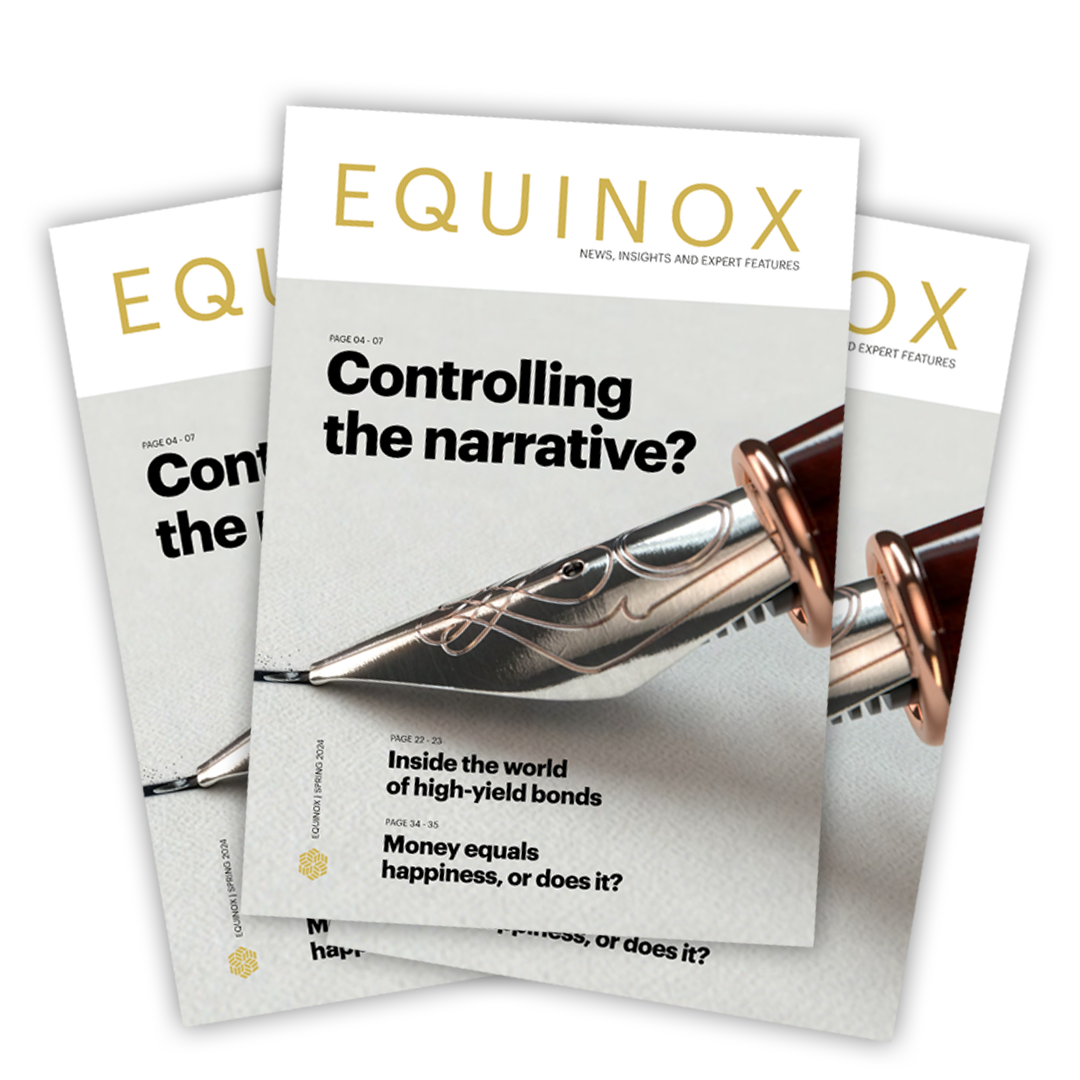Of course, you are a responsible investor! You have control over your finances and are careful about where you place your money for growth. You are comfortable in your level of risk and keep yourself abreast of market news to maximise returns. In fact, if you do say so yourself, you can be credited for the many benefits that you and your loved ones have enjoyed from your ability to manage money so responsibly to date.
What if we pose a different, perhaps a more helpful, question?
Are you a response-able investor?
A response-able investor is exceptionally well positioned to ensure that their finances grow and thrive. How? Because they can respond both quickly and positively (the combination here is key) to an external stimulus.
When the world changes, and let’s face it, the stimulus on the markets has been plentiful over the past few years, then it is vital to respond in a way that is informed, rational and dispassionate, rather than reacting out of urgency.
Take a moment here to pause and reflect, honestly, on how you may habitually react to market changes.
The response-able investor does not ‘react’ spontaneously to changes in the market. Instead, they are equipped to ably ‘respond.’ The former is an action of speed and low consideration. The latter is an informed place of choice and information, enabling a balanced and healthy decision to be made.
At this point, it seems only logical to point out that we are ‘Equilibrium’ both in name and by nature. Our very existence is to ensure a balanced state where opposing forces are in play. It is our aim to equip every single one of our clients to become able to respond and not to react when things change, whichever direction the markets turn.
When opposing forces threaten to become unbalanced, the response- able investor can affect and maintain the state of equilibrium.
Being a response-able investor has one single, significant and undeniable benefit – it helps you to protect your investments by being better able to maintain a balanced, dispassionate response when the market – or the world – changes.
So, how do you come a response-able investor?
Our investment team and our financial advisers see clients every day who gain (quite literally) from being a response-able investor. They tend to display the following six attributes:
1. Mind the gap
Investing successfully means marrying and managing the complexities of your life and personal needs with the complexities of the wider world and chosen investment.
Like it or not, our money is linked with our emotions. ‘Mind the gap’ between the two by creating an action plan in advance for when the challenging period hits so that, when it does, you are making decisions while clear-headed, not once emotion takes hold.
The response-able investor: Accepts that when reviewing performance, emotion will affect their perspective. They have considered, in advance, how changes in the market may trigger changes in their emotion.
2. Break the bias
Being human, our psychology determines and defines how we behave. Becoming self-aware of the behavioural biases associated with investment, helps us to remain balanced. Understanding our own herd behaviour, our susceptibility to anchoring or self-attribution for example, will prepare you for not being triggered by the market.
Taking the time to know your own psychology can have a huge payback. See our related article ‘Unlocking your financial DNA’.
The response-able investor: Not only acknowledges but actively practices positive behavioural investment. They are aware of the biases and look to form new, more helpful habits.
3. Know your bulls vs bears
As Warren Buffet, the sage of Omaha tells us: “The stock market is a device for transferring money from the impatient to the patient.”
You WILL experience market drops and investments WILL fall in value. They’re not fun but they don’t last forever and at some point, they WILL eventually recover.
The facts are that the longer you leave your investment, the better your odds for a positive return. Knowing the realities around bear and bull markets is helpful.
A ‘bear market’ is defined by Investopedia as a period when markets fall from peak to trough by 20% or more. The average bear market fall lasts 289 days with a 37.3% dip.(1)
A ‘bull market’ is a period when stock prices increase, usually by 20% or more over a minimum of two months.(2) Historically, bull markets last on average over five years and bring a 198% return.(3)
The response-able investor: Grounds their investment in the figures around the pattern of the bull and bear market. They know that checking their investments daily will not support them.
4. Beware of apples and pears
There is a huge danger in making comparisons, especially in defaulting to oversimplified labels such as ‘returns’ or ‘against the FTSE.’
The term ‘investment’ covers a phenomenally wide range of activities, all with the same objective to generate profits. However, that is the only commonality they share.
While investing in a newly formed company may triple your money over one or two years, the risk levels are high; 60% of new businesses fail in the first three years.(4) Compare this to investment in a global company and your expected levels of both risk and returns are lower.
The FTSE 100 is often used as a common yardstick for investment performance. The reality is that modern portfolios are not usually invested solely in an index but include an array of other investment types, across multiple sectors around the world.
The response-able investor: Avoids comparing apples with pears and is sure to select an appropriate and equivalent benchmark for measuring performance.
5. Beyond the bottom line
Look through the bottom line to the actual amount of return you will receive. It is impossible to invest without incurring costs, such as stamp duty on shares, platform and/ or fund charges.
When comparing investment performance returns with any benchmark, competitor or alternative, it’s worth being aware that they will likely not reflect fees or taxes that apply, thereby overstating their return.
This is particularly relevant when considering property investment where taxes and costs of ownership are high.
Investment performance can also be skewed if you make additional contributions or take withdrawals.
For example, if you invest £10,000 at the start of the year and the investment increases by 10% over 6 months, you will see an increase of £1,000. When added to your initial investment this makes your total now worth £11,000.
You then invest a further £10,000, bringing your total to £21,000. Over the next 6 months the investment drops by 5%. Remember, it went up by 10% initially so after the 5% drop it is still up 5% over a year.
However, you have £21,000 invested at the 6-month point so when the investment falls by 5% your £21,000 drops to £19,950.
This creates a strange situation where the return is up by 5% over a year but you haven’t made any money and, in this example, have made a small loss!
The response-able investor: Is mindful of taxes, charges and flows of money when comparing performance to an alternative.
6. Timing is everything
As is the case in life, when it comes to investing, timing is everything.
When comparing investment performance, it’s vital that you are precise and consistent with dates. The performance of one portfolio will be very different to another if the time period being assessed differs, even slightly.
For example, had you invested in the FTSE AllShare over the previous full tax year ending 5 April 2023, you would have seen a total return of 2.27%.
However, if you had invested in the FTSE AllShare over the 12 month period ending 1 August 2023, you would have seen a return of 5.82%, despite the time periods overlapping by eight months.(5)
The underlying investment wasn’t intrinsically any better or worse, it was the same but just over a slightly different period.
The response-able investor: Ensures that performance comparison periods match precisely – to the day!
This article is intended as an informative piece and should not be construed as advice. If you have any further questions, please don’t hesitate to get in touch with us.
Sources
(1) Stock market outlook nasdaq bear market sell- off yields recession (businessinsider.com)
(2) What is a Bull? Definition in investing, traits and examples (investopedia.com)
(3) History suggests S&P 500 hits 3000, next bull market takes it to 6000 (investing.com)
(4) How Many Businesses Fail in the First Year in the UK? (businessinsolvencyhelpline.co.uk)
(5) FE Analytics



